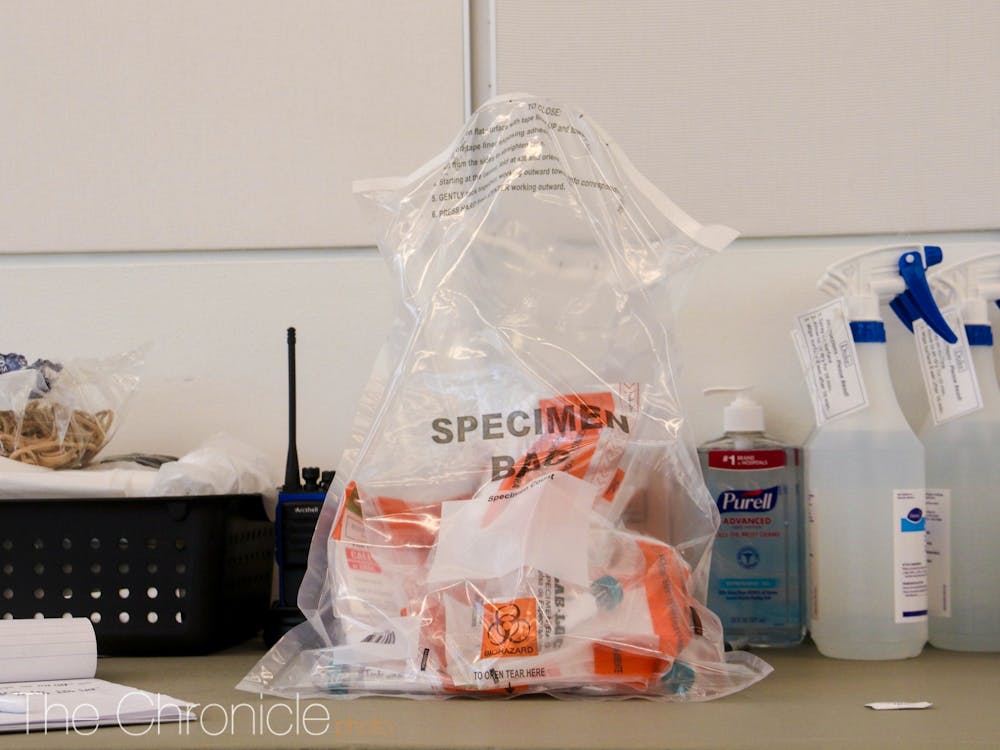Undergoing a test for COVID-19 was a shared experience for members of the Duke student body during the move-in process this month. However, this has not been their only experience with coronavirus testing.
In an Aug. 13 email to undergraduate students, Duke announced a pool testing program intended to “protect the health and safety of the campus community during the fall semester.”
All of this is part of Duke’s reopening plan, which seeks to contain the spread of the virus throughout the campus community while offering some amount of in-person instruction. And when it comes to that plan, one entry test wasn’t enough.
Tests began the week of Aug. 17, starting with on-campus undergraduates and expanding to other community members. Duke undergraduate students selected for testing received email and text notifications of self-administered COVID-19 test appointments to take place at one of numerous locations across the Duke campus, including the Bryan Center and the Gilbert-Addoms Residence Hall.
When first-year Vinnessa Van received a notification for pool testing, she felt what she called a “combination of dread and acceptance.”
Others, however, were not as surprised when they received the notification.
“I had kind of been anticipating it for a while,” first-year Kathryn Thomas said. “I was waiting for that notification to pop up on my screen.”
At the beginning of these individual appointments, clinicians from Student Health, Duke Hospital, the School of Nursing, the School of Medicine and other partners give participating students a testing kit that consists of a collection tube, cotton swab, and plastic bag.
In an approximately five-minute process, students first scan the barcode on the test tube with the SymMon app—the same app used for daily COVID-19 symptom monitoring. Participants then self-administer the test under the supervision of the clinicians by inserting a cotton swab a far enough distance into each of their nasal passages to where the tip of the swab is no longer visible. Participants rotate the swab along each inner nasal lining three times. The swab is then placed into a collection tube and finally into a bag.
Both Thomas and Van felt that one of the most distinguishing features of pool testing is the sheer ease of the process.
“It was super close to my dorm...there was no line,” Thomas said, “The simplicity of it was honestly shocking.”
Results from these tests usually take approximately 48 hours to process, and students are only notified of their test results if they are positive, which Thomas wished would change.
“I guess it makes sense on the back end, to limit communication.” she said, “But it would be nice to know: Am I clear?”
According to data released Aug. 31 on Duke’s testing tracker, 802 pool tests have been given to faculty members and 7,471 to students. Of those tests, zero faculty members and two students were positive.
Regardless of their personal feelings toward this process, both students acknowledged the greater purpose of the surveillance tests, what Thomas described as the expectations of students who wish to remain on campus.
“The fact that Duke is willing and capable and has the resources for us to have [pool testing]...is doing wonders to check our health and safety,” Thomas stressed.
Get The Chronicle straight to your inbox
Signup for our weekly newsletter. Cancel at any time.
Amy Guan is a Pratt senior and a senior editor of The Chronicle's 119th volume.

